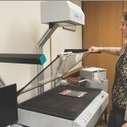Computer science and the humanities don’t have anything to do with each other, do they? Code belongs in Sci, and books stay in the seminar room, right? Wrong! The two disciplines come together in digital humanities, a set of research methods that takes computer-assisted approaches to disciplines of the humanities. At Swarthmore, the college’s small size and liberal arts focus have produced a rich variety of digital humanities work spanning various departments and have positioned community members to make serious contributions to the digital humanities, even beyond campus.
Associate Professor of English Literature Rachel Buurma ’99 integrates digital humanities approaches in her classroom, as well as in her own research and published work. In Buurma’s “Rise of the Novel” course, which is taking place this fall, upwards of thirty students spend part of each week learning how to use data visualization tools, text mining, and digital mapping, among other computational methods, to analyze individual eighteenth-century novels.
One assignment, for instance, asked students to run a computer program which would extract all mentions of geographical locations from a digital version of Daniel Defoe’s Robinson Crusoe, create a map of these locations using Google’s MyMaps, and compare this map to one included by eighteenth century printers in early editions of the novel.
Now, Buurma’s students are applying text analysis to a wider set of novels in order to situate the smaller set of books read in the class within their greater literary context.
Via Karianne Lessard



 Your new post is loading...
Your new post is loading...








Nous ne sommes pas les seuls en CMN2570, à l'Université d'Ottawa, à tenter d'innover dans notre manière d'enseigner! Étonnant de voir comment utiliser les techniques des digital humanities peut motiver les élèves à travailler plus fort sur des sujets qui peuvent parfois leur sembler dépassés comme c'est le cas des romans du 18ième siècle.